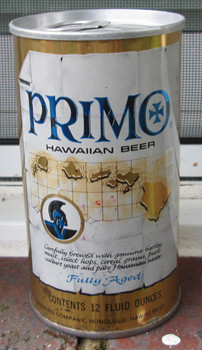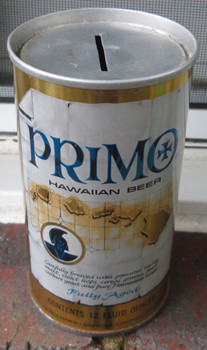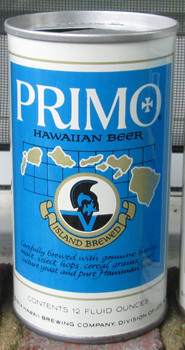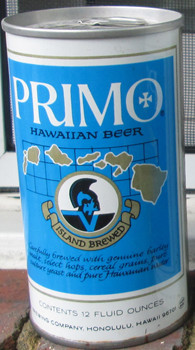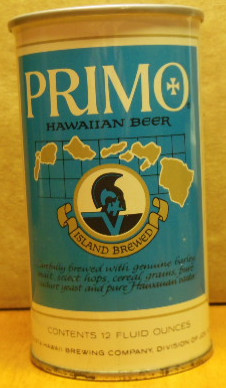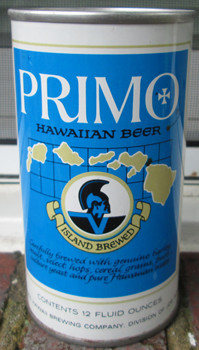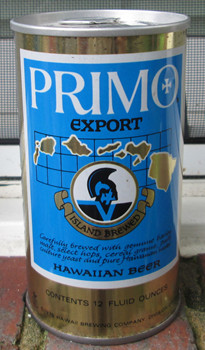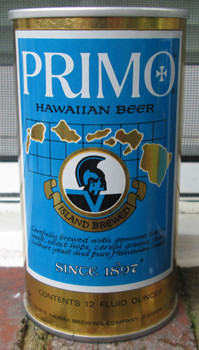Primo Cans: 1974-1976
Primo Begins Canning Again: 1974-1976
Back in issue #143 (October 2006) I discussed the famous aluminum Primo flat-top can from 1958. There is an update in it that’s below, but I wanted to focus this time on the second attempt to can Primo made by Schlitz starting in 1974. I am trying to get all the variations of every Primo from the original through the new ones, so if I miss some please let me know!
I started collecting Primos as a teen in 1976. My family went on vacation to Hawaii that summer and I collected every can I could get my hands on. I brought several of the then-current white/blue Primos back to Dayton and my fellow Ohio collectors snapped them up quickly in trades. It was not until I started collecting again in 2000 that I found out that there were a lot more Primos I’d missed over the years.
The cans I brought back were part of an effort for Primo to regain lost market share. The brewery’s aluminum cans that they used from 1958-1961 were a famous disaster and Schlitz took over in 1963. The new owners turned the business around. Brewing of Primo Beer expanded and the brewery went to 24 hour a day operations. By the beginning of the 1970s, Primo Beer market share peaked with 70% of the local market. In part this was due to local loyalty since this was "Hawaii's beer", but the tourist trade also helped as the many visitors to the islands wanted to try the local brew.
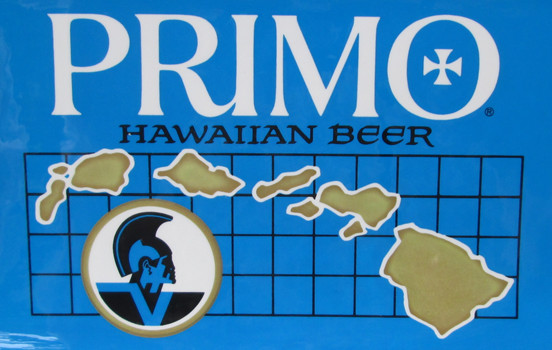 |
The downfall of Schlitz from one of the big three US brewers along with Anheuser-Busch and Pabst is well-known. To cut costs brewery management began reducing the time lagering their beer and using adjuncts that reacted poorly, often creating a disgusting protein sludge. It’s a classic example of short-term thinking destroying a classic brand. But while the Schlitz story is well-known, the brewery management’s desire to cut costs also affected their management of Primo in Hawaii. Rather than make the beer entirely in Hawaii starting about 1970 they shipped dehydrated wort from Schlitz’s Los Angeles facility to Hawaii, where water and yeast were added. The taste apparently suffered. Back in 1977 I worked on a GM assembly line with a Vietnam-era Navy veteran who had been stationed at Pearl. I asked him about Primo in the early 70s. He called it “seagull piss” and said once the brewery brought a truckload to the sailors to give away for free, and the sailors refused it. Between 1970 and 1974 market share for Primo in Hawaii dropped from about 70 percent, to less than 60, then to below 30. Olympia became the islands’ best seller with Budweiser in second place.
The story spread that the brewery was selling green (under aged) beer which the brewery insisted was just a “rumor” with the brewmaster in 1974 saying “green beer” was a “stuff and nonsense phrase” used by competitors to disparage another. “The aging of the beer” he said” occurs at the brewery, not latter.” That was, in fact, the problem. The beer was not being aged enough at the brewery. Schlitz President Robert A. Uihlein Jr. did admit in early 1974 that “the quality did deteriorate for several months,” a clear understatement. To be fair, the market in Hawaii was dominated by cans rather than bottles and Primo was not canning when their market share dropped. However, the sudden drop from selling almost three-quarters of the beer in the state to selling under a third was not likely to be the result of a sudden consumer demand for only canned beer.
On April 1, 1974 Primo began canning again. These were the gold-labeled cans noted below, and there was an 11 oz bottle as well. The beer was now made entirely made in Hawaii, starting with the dry grain. Even the cans were made locally. The cost of shipping cans from the mainland had been a major reason why Primo had not canned beer before 1958, and why they tried their experiment with the new light aluminum cans. Schlitz also set up a program where they paid for returned cans and bottles at the brewery, 12 cents for a case of cans and 44 cents for a case of bottles of Primo or other Schlitz products.
The new can and bottle label really played on the beer’s local roots. It prominently featured a map of the islands and the head of King Kamehameha I (1758-1819) who first united the islands. The words “Fully Aged” appeared on the bottom front center, probably due to the green beer rumor. Finally, the brewery bragged that Primo listed all its ingredients on the label. Indeed it does. Between the map and “Fully Aged” the label read “Carefully brewed with genuine barley malt, select hops, cereal grains, pure culture yeast and pure Hawaiian water.” “Cereal grains” is a bit vague, but I like the use of “pure” twice.
The gold label can appeared in two variations of which I am aware. There is the regular pull-tab, and a bank top. Both are copyrighted 1974. However, the gold label was short-lived. On November 1, 1974 the new Primo brewhouse officially opened. The brewery also introduced new version of Primo, a lighter lager that had been test marketed in Milwaukee and Hawaii both. A new 12 oz bottle with a tall narrow neck replaced the old, squat 11 oz. The new label was lighter than the gold version and the dominate color was blue rather than gold: the king’s head prominent in the front center with an outline of the islands above. “Hawaiian Beer” and “Island Brewed” appeared along with the ingredients. The phrase “Fully Aged” was dropped. The brewery packaged 60% of their product in cans and the rest in bottles. There is no mention in the stories about the new brew houses of selling draft beer.
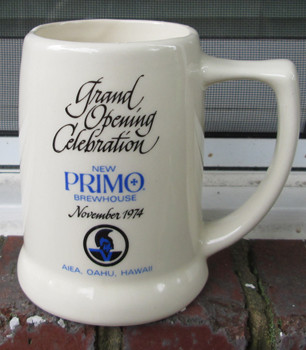 |
Primo Grand Opening Mug
I know of four variations of the blue/white label.
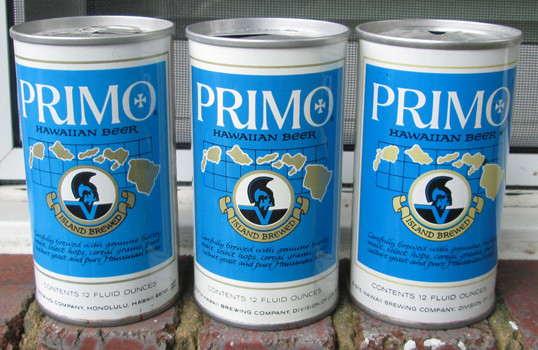 |
The first three are all dated 1974 in the mandatory. Two are pull-tabs. The most visible difference is the shade of the islands with one darker than the other. Also, one of the cans lacks the copyright “R” after Primo on one side, a truly small difference. My guess is that this was the first one, and then the missing copyright symbol was added. There is also a bank can version of the 1974 can. The fourth version has a 1975 date and the islands are very light-colored. The two 1974 pull-tabs I have all have lids with “PRIMO” embossed and the 1975 can does not. I do not know if this is true of the other 1974 and 1975 cans as I did not consider this to be a different version for the purpose of this list so I have not done a comparison.
A new darker label came out in 1975 for a can made for export. Primo was either shipping, or planning to ship, its beer to Samoa, the Philippines, Taiwan, and Japan. This was not the first time Primo had been exported. They shipped bottled beer into the South Pacific during and before the Second World War (I have been sent photos from a museum in former French Polynesia of bottles with “Primo” embossed on the glass.) This new label was dark blue with gold replacing the white. The islands also now appear in gold. The export can is dated 1975 and has the UPC code on the side.
This darker label became the domestic label as well, probably in late 1976 as that’s the date in the mandatory. Where the Export version had “Hawaiian Brewed” under the ingredients, the domestic version had “Since 1897.” There is also a bank version of this can. Canning beer in Hawaii was still expensive, so in 1979 Schlitz moved the canning operation to the mainland. Unfortunately, moving the canning operations only weakened the local support in Hawaii for "their" beer.
I will continue with additional variations in a later article. I have over two dozen variations as of this writing, so there are lots more to go. If you know of additional variations, please let me know!
Oh, and back in 2004 I did not know there were two variations of the 1958-1961 paper-label Primo. On one the mandatory reads “packaged” and the other reads “Brewed and Bottled.” Newspaper articles and advertising also indicate that the brewery continued trying to market their beer in cans through late 1961, rather than discontinuing them in 1959 as originally assumed.
Primo Pull-tab Variations: 1974-1976
Variation # |
Photo |
Notes |
1 |
|
The first can. gold/white/blue. Copyright date of 1974. |
2 |
|
The same can, but made as a bank. |
3 |
|
The blue & white design. Copyright 1974. This one is missing the copyright ® after the word “Primo’ on one side. The islands are a light color. |
4 |
|
Also copyright 1974. This one has the copyright ® and the islands are a darker color. |
5 |
A bank can. Dated 1974 |
|
6 |
|
Copyright 1975. The islands are a light color and the font for the mandatory is slightly different. This is the can I brought back from Hawaii. |
7 |
|
Gold and blue, copyright 1975. This is the “EXPORT” can. It’s the first Primo with a UPC code on the side. |
8 |
|
The same gold/blue design, but copyright 1976. It must have come out later in 1976 because the white/blue version was still for sale when I got mine in late June. |
9 |
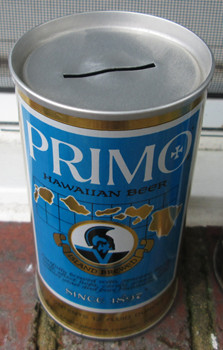 |
The gold/blue design as a bank can. |

